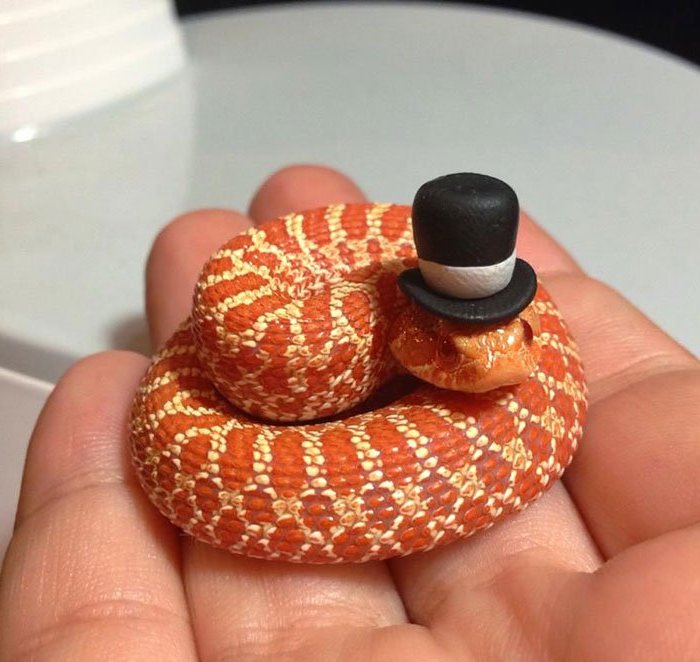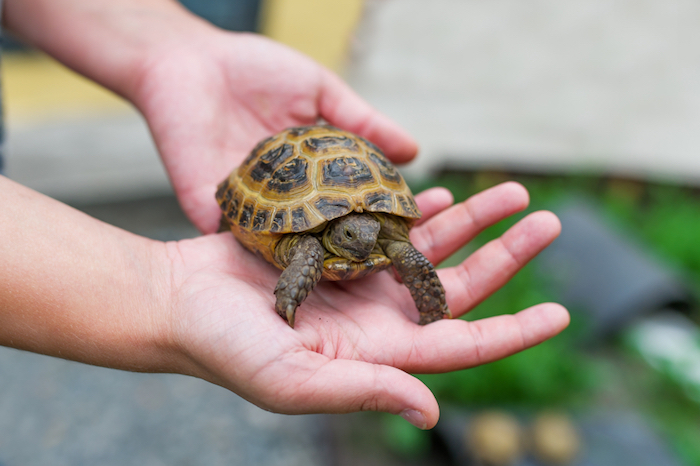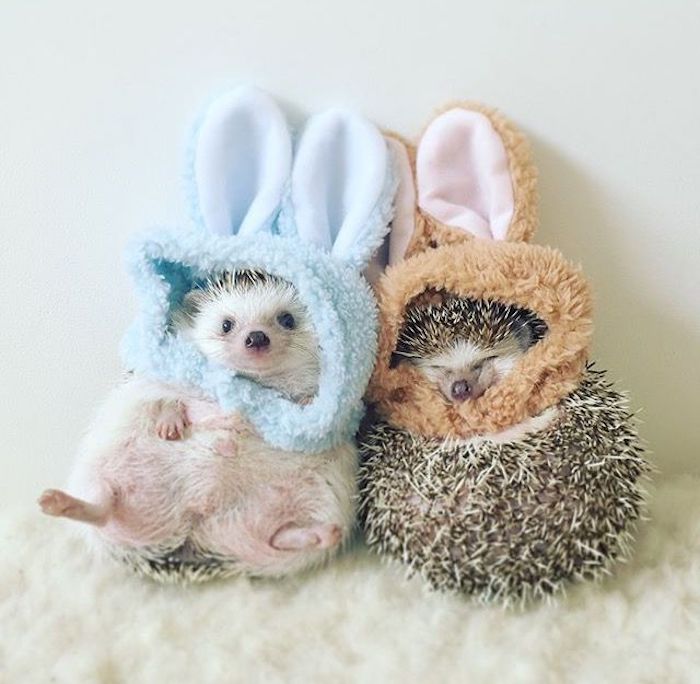The Top 10 Unusual and Exotic Pets You Can Legally Own
Every now and then, we see photos of people playing with their exotic pets, and it always seems like everyone is happy and having a great time. But is it really that easy to take care of wild and unusual animals at home? Is it even legal?
This article will answer all of your questions! We have compiled a list of the top 10 best exotic pets that are perfectly legal to own. Scroll down to see them all, and you will find lots of interesting information, cute photos, as well as a special surprise at the end!
Hedgehogs are some of the most popular exotic pets at the moment

10. Chinchillas
Cute, fluffy and sociable, these little critters are a very popular choice. This is largely due to their cute demeanor – they resemble an adorable cross between a squirrel, a hamster and a rabbit. In addition, they are generally very friendly, relatively easy to care for, and can even be kept in apartments.
Although the chinchilla are not fussy and quite adaptable, there are several points to consider before getting one as a pet. Firstly, this little rodent is quite active and loves climbing. In order to ensure its full comfort, choose a larger cage, with at least two levels, and lots of climbing toys. Secondly, it is a social animal, who loves interacting with others. You need to spend time bonding and playing with it every day. If your schedule does not allow you to do so, it is advisable to get two or more animals, so they can keep each other company.
A stuffed toy? No – a baby chinchilla!

Chinchillas are gentle and patient creatures

Another important point is that chinchillas are highly active at night. Once it gets dark, they start climbing and running about their cage, so it is advisable to place it as far away from your sleeping area as possible. If you have a terrace or garden, you can put your chinchilla’s cage out for a few hours a day. However, bear in mind that these little creatures should be kept away from direct sunlight. It might be best to take the cage out in the evening when the sun is setting.
Chinchillas love being hugged and cuddled but you need to give them enough time to get used to you first!

The chinchilla ears are very sensitive, and it does not do well in loud environments. Keeping it close proximity to noisy animals will make it irritable and anxious, and can even lead to fatal conditions and death. Be careful to put its cage in a quiet area, away from bright light.
“My ears are large for a reason – please don’t yell!”

Letting your chinchilla roaming free in the garden is not advisable, as its little body is susceptible to parasites and disease. In addition, it might be in danger of being attacked by a neighboring cat. If you would like to give your chinchilla a taste of freedom in spite of these dangers, make sure you have it thoroughly checked for internal and external parasites afterwards!
“Yes, that’s the spot!”

Bond with your chinchilla by gently offering it tasty treats

Chinchillas are very clean animals but they never bathe in water! Instead, they keep their fur spotless by rolling around in special dust several times a week. You can buy some online or at your local pet store.
Chinchillas are highly social animals

Their fur is so silky soft that people used to hunt them in the past!

Like most exotic pets, chinchillas need some additional care

9. Tarantulas
Arachnophobes – look away now! The next few images are not for the fait of heart! In truth, these ginormous spiders may seem menacing on the outside, but they possess a mostly timid disposition. Contrary to popular belief and urban legends, most of these crawlies are not even venomous to humans. Usually, their bite is about as painful and dangerous as a wasp sting and, unless you are allergic, it is quite harmless. In fact, keeping a tarantula as a pet is more perilous for the creature itself. Although they are the largest spiders out there, they are still quite fragile, and can be easily injured or killed.
Mexican redknee tarantulas are very common and popular exotic pets

Although there are many different species to choose from, if you are beginner, it is best to opt for an earth dwelling tarantula. The Mexican redknee (Brachypelma smithi), Chilean rose (Grammostola rosea) and Curlyhair (Brachypelma albopilosum) tarantulas are a great choice for unexperienced breeders, as they are slower and more peaceful than other species. Plus, they allow to be handled and rarely try to escape.
“Hello, friend!”

A gorgeous cobalt blue tarantula, weaving its web

Tarantulas in vivid colors have become increasingly popular as pets in recent years. That’s hardly surprising – they are beautiful and unusual, and really stand out when compared to other species. However, their bright coat usually signifies potential danger. The cobalt blue tarantula, for example, is a gorgeous spider, that has enjoyed a lot of attention, and although it is definitely nice to look at, it is also aggressive and very fast. Its venom can cause severe infections and irritation. Other species, like the Brazilian pink bloom tarantula, rub their hind legs together to release tiny sharp hairs when they feel irritated. These are extremely irritating to human skin and can lead to painful results.
Pretty but dangerous!

Brazilian pink blossom

One of the most important questions you need to ask yourself before getting a tarantula as a pet is whether you would be comfortable feeding it. Smaller tarantulas need to be given living crickets, roaches, grasshoppers or beetles, while larger species eat small birds, lizards or mice.

8. Parrots
Parrots are some of the most popular exotic pets out there. Beautiful, social and exceptionally intelligent, they make great companions for children and adults alike. In addition, some of them have the ability to mimic various noises, including human speech. Depending on the size of your home, and on the amount of resources you are willing to part with, you can either choose a small decorative bird, like a budgerigar, or go for a large talking parrot. The African grey is the most widely spread species, as it is extremely smart and can easily learn to repeat various phrases.
Your very own feathery cuddle buddy!

Parrots are by no means fussy, but there are some conditions which can have negative impact on their health. Cigarette smoke, for example, is extremely toxic for them. In addition, they need to spread their wings from time to time, so it is essential to let out from the cage on a regular basis. It is advisable to release them in a room which has no sharp edges or potentially harmful objects.Good hygiene is incredibly important for birds. Ensure that your pet has a small water tub in its cage, so it can refresh itself and keep its feathers neat and clean.
Macaws have beautiful multicolored feathers

“Is that a cracker I see in your hand?”

Like all birds, parrots love seeds but if you want your little feather buddy to be healthy, you need to bring some diversity into its diet. Try introducing raw fruit and veg into its menu (but avoid avocado, as it is toxic for birds). From time to time, treat your parrot to boiled eggs and bread crumbs. It might sound strange feeding a bird with eggs, but in fact they contain important nutrients that will help your pet grow up strong.
“Just relaxing with my human”


An adult African grey parrot

7. Snakes
Snakes are beautiful and majestic creatures that make great pets. However, they require very specific care and a lot of attention, and are not suitable for every household. Taking care of them can be quite expensive too. They require a warm and well-lit terrarium, with lots of space. In addition, bigger snake species eat mice, birds and rabbits, which need to be especially ordered, and can cost a small fortune. Nevertheless, every snake owner will happily tell you that it is all very much worth it, and that once tamed, these slithering critters make charming companions.
Small, non-poisonous snakes are great exotic pets


Although most pet snakes are perfectly harmless for children, it is advisable to supervise all encounters

Sharply dressed little snake

“Give us a kiss!”



“I’m a bunny, I swear!”


The rare and magical unicorn snake

6. Ferrets
Cute, small and fluffy, ferrets seem like the best exotic pets ever. However, beneath their cuddly exterior lies a naughty, hyperactive little critter that is bustling with energy. Although it can be tamed, the process will most likely involve at east a few bites, and a lot of broken household objects.
Before getting a ferret, carefully consider whether you’s be patient enough to provide the care and attention it needs – despite its tiny size, it can do a lot of damage to your home! Not recommended for buys individuals or families with babies or small children.

How cute is this ferret kit?



Although it takes them a while to get used to it, ferrets can be walked on leashes


“I am ready for my close up”

5. Turtles and tortoises
Many people opt for turtles or tortoises, thinking they are a cheaper, “easier” alternative to a puppy or a kitten. They couldn’t be more wrong! Turtles are complex organisms, which require very special attention and lots of care. It is not sufficient to simply get an aquarium for your animal – you must also provide bedding, food and vitamins, and ensure that the temperature, light and humidity are at the appropriate levels. In addition, it is essential to find out where your pet turtle or tortoise comes from – as a general rule, people should not attempt to care for turtles who have hitherto lived in the wild.

“What a strange puppy!”


The red eared slider is the most common turtle on the exotic pets market


The perfect home for your turtles


“Has anyone seen Mario?”

4. Llamas and alpacas
Native to South America, llamas and alpacas are becoming increasingly common around the world. Their friendly disposition and clean habits make them an excellent pet for people who live in rural areas. It goes without saying that these cuddly, long-legged creatures need a lot of space to graze and roam about, so make sure you have a large garden (and kind, animal-loving neighbors) before purchasing one!
Friends for ever!



“Can I bring my blankie?”

No drama llama!


3. Hedgehogs
Hedgehogs are the most popular exotic pets at the moment, as evident from the numerous Instagram accounts devoted to their care. No wonder, really – they are simply adorable, and can adapt to indoor life quite well. Plus, they prefer solitary life, so you don’t have to worry that they’ll get lonely. Their diet is quite simple too – they munch on insects and fruit, although you can also purchase special hedgehog food. The only real downside to having a pet hedgehog is that its living area needs to be cleaned every day.


“I am a shark!”


How cute is this hedgehog couple?


“Wait, who are you??”


Huff, the vampire hedgehog is an Instagram star

2. Miniature (teacup) pigs
These little cuties are also gaining more and more popularity, due to their incredible intelligence and adorable demeanor. They are very easy to care for, and can be trained to walk on a leash, and perform various tricks.
Overall, they make delightful pets, and get along with people and other animals quite well. Just bear in mind – despite bearing the deceptive name “miniature,” your little friend will not stay tiny forever! Teacup pigs can grow to weigh up to 65 pounds or more. Although this is pretty small when compared to other pig breeds, they are by no means a little pet! Make sure you have enough space and recourses to keep them happy and healthy.
A charming ballerina


Giant rabbit or tiny piglet? You decide!



Piglets love resting in the sun! Make sure they don’t overdo it though – too much heat can be harmful.

I think it’s quite obvious who’s the alfa dog in this picture…

- Mini horses
Miniature horses are more than exotic pets – they are the dream of almost every child on the planet! Graceful and cuddly, these little buddies have a very friendly and calm disposition, which makes them the ideal pet for families. Besides, they are resilient and adaptable, and don’t need as much space as larger breeds.

Thumbelina, the world’s smallest horse


Forget diamonds! Ponies are a girl’s best friend!


Best friends


BONUS – Fennec foxes!
There has been a lot of discussion surrounding the domestication on fennec foxes. Is it right? Is it ethical? Do they even make good pets? We must admit that we don’t really have the answers to those questions. What we do know is a) they are the cutest animal we have ever seen and b) they are definitely not a good choice casual pet owners. Loud, hyperactive and prone to digging, they are definitely a handful!


How adorable is this fennec kit?

Sleeping soundly


Fennecs can be walked on a leash…

… and even taught to play f












